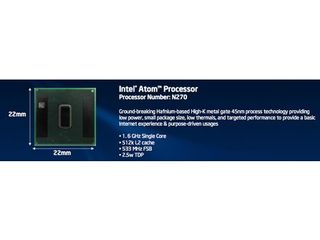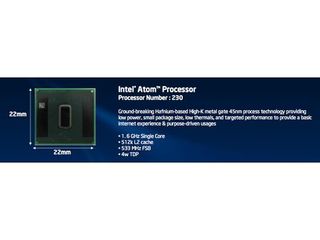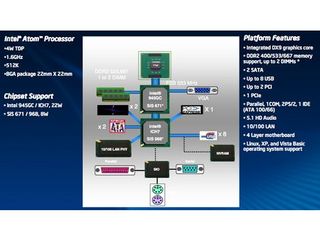Intel Atom CPU Review
Atom N200 and i945
For Atoms intended for standard PCs, Intel will offer another line of processors (Diamondville). The Atoms of the N200 and 200 series are meant for standard PCs, but more specifically low-cost portable PCs, like the Eee PC and its competitors.
Atom N200 and 200: The Price Is Attractive
The Atom N200s are similar to the Atom Z500, with the only differences being in the management of EMT64 (64 bits), present in the N200 and 200 models, and the absence of EIST. The Atom 200s, then, don’t change frequency on the fly. The prices are attractive: An Atom N270, with a frequency of 1.6 GHz (533 MHz bus) and a 2-W TDP costs barely $44. And the 230 version, with a 4-W TDP, costs a mere $29 (at the same frequency).


A Veteran Chipset: The i945
The main problem with the Atom N200 stems from the chipset: Intel offers only variants of the i945. This chipset, already “old” (it dates from 2005), has a major fault: It consumes a lot of power (22 W in the GC version). The i945 chipset supports modern technologies: SATA (2), PCI-Express (1 lane via the ICH7), HD Audio, etc. Obviously it can handle DDR2 memory (on two channels) and includes an IGP, the GMA 950. Still, it’s obvious that using an older chipset (from the Napa platform) with a TDP that’s ten times higher than the processor’s is not the best idea in the world. But it’ll have to do until something better comes along. Portable PCs use the i945GSE, which uses only 5.5 W (4 W for the Northbridge and 1.5 W for the Southbridge). Obviously, the performance is not the same – in 3D, essentially, where Intel has reduced the GMA’s frequency (from 400 to 133 MHz).

The GMA 950

Now let’s take a look at the GMA 950, the IGP used by Intel in the i945 chipset. Compatible with DirectX 9 and capable of running Aero, it is very common in portable PCs equipped with a Core Duo processor. Its performance is weak and it’s incapable of decoding HD formats. What’s more, it’s sensitive to memory bandwidth and its drivers are not optimized. Finally, Intel uses several frequencies for its IGP – from 400 MHz in the i945G versions (for desktop), it goes as low as 250 MHz in portable PCs and 166 MHz in some ultraportables (with the attendant loss of performance). The version used by the Atom (i945GSE) is limited to 133 MHz, whereas the i945GC operates at 400 MHz.
Note that Intel also proposes coupling the Atom to an SiS chipset. This solution, already offered in Intel Mini-ITX boards, uses a SiS 671 coupled with a 968, and consumes only 8 W.
Stay on the Cutting Edge
Join the experts who read Tom's Hardware for the inside track on enthusiast PC tech news — and have for over 25 years. We'll send breaking news and in-depth reviews of CPUs, GPUs, AI, maker hardware and more straight to your inbox.
Current page: Atom N200 and i945
Prev Page Atom Z500 and SCH (Poulsbo) Next Page Atom: In-Order and HyperThreading-
joefriday Celerons have significantly lower frequencies than Atom? umm...no. Only the ULV celeron M has a lower freqency. Modern notebooks start with Celerons at least 1.6GHz, more likely 1.86GHz, and are built on the much more modern Merom architecture, which have at least a 10% IPC advantage over the old Dothan architecture. No, atom is nowhere NEAR a modern Celeron in performance. Nice try though.Reply -
joefriday Also, Why not have a Celeron 420 by now? Are you telling me that THG, with all its money, can't budget in a $30 CPU for comparative testing?Reply -
joefriday After reviewing the article, I can say I'm thoroughly unimpressed with the Atom platform (at least the current desktop derivative). If anyone can remember, THG did a $300 PC build using now ancient Celeron Ds and AMD Semprons. One thing that I find amazing, is that those old rigs both use LESS power than this Atom desktop rig.Reply
http://www.tomshardware.com/reviews/the-300-pc,1546-10.html
-
randomizer Don't you people understand that Atom is not a desktop processor? You can't compare its performance to a desktop processor fairly because that's not what it is designed for.Reply -
joefriday This Atom CPU is on a desktop board. That means it's fair game, especially when the processors being compared are also comparable in price.Reply -
randomizer It's on a desktop board, woopdedoo. If you could get your mobile phone processor to run on a desktop board would you compare it to an E2160?Reply -
joefriday Who cares what the Atom CPU is SUPPOSED to be. It is right now, in this review, on a desktop-oriented package, built to compete with low power consumption desktop computers. It fails miserably in that regard, as it is neither low power consumption, nor competitive. In your ridiculous example, if I had a mobile phone processor on a desktop board, and it ended up consuming more power than an E2160/motherboard combo that costs the same amount of money, all the while performing much worse than the e2160, I would call the mobile phone cpu on a desktop motherboard either A FAILURE or AMD. Take your pick.Reply -
apaige So, for the Intel Atom, you do use an updated version of Sandra, but not for the Phenom. You compare it to the VIA C7, a 3 year-old CPU, but not the VIA Nano, which will be available in the same timeframe as the Atom. You don't provide graphics for power consumption, despite the Atom being designed for low power consumption; surprise, the old C7-M system draws less power.Reply
Biased much? -
Not sure that Nano's are really available yet, still a newer mini-itx based C7 (say EPIA-M700) would have been better, since you would be looking at even less power than the one used and the VX800 will end up used with the Nano. The D201DLY would have been good to compare to, would also give some idea how the Atom would go paired with SiS chipsets.Reply
Most Popular

